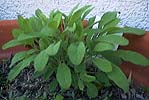
Subject: Sage
COMMON NAME (English/German): Sage/Salbei
LATIN NAME: Salvia officinalis
TYPE OF PLANT: perennial "subshrub"
SYMBOLISM: wisdom, long life
- MEDICINAL: for cold symptoms and digestive upsets; lowers
blood sugar in diabetics
- bath: stimulates the skin
- cosmetic: used in soaps; also as an insect repellent (flies);
mixed with lavender to make a soothing, astringent aftershave
-
- EDIBLE: Young leaves are eaten fresh in salads and cooked in
omelets, fritters, soups, yeast breads and rolls, marinades,
sausages, meat pies, and poultry stuffing. They are also cooked
with all kinds of meats and a wide variety of vegetables.
- Herb vinegar--sage, parsley, shallots with red wine vinegar
- Tea blend--tansy, sage and rosehips; jasmine, orange peel and
sage
CULTIVATION: sow in late spring and transplant to 20" apart when
seedlings reach three inches high; or divide an established plant and
use the outer growth for replanting. Prune plants severely in the
spring and replace them every three years or so.
- zones: 4-8; native to N. Mediterranean coast, cultivated as
far north as Canada.
- soil pH and composition: moderately rich, pH 6.4
- planting time: after danger of frost has passed
- bloom time: June
- sun and water: full sun, well-drained
- companions/threats: Good near cabbage, carrot, strawberry,
tomato and marjoram. Bad around onions. Repels cabbage looper,
cabbage maggot, cabbage worm, carrot fly. In danger from root rot,
slugs, spider mites and spittlebugs.
HARVESTING AND STORAGE: To dry sage leaves, snip t hem from
branches you have removed, discard the stems, and spread them on
cloth or paper in the shade. Store in a colored glass or solid
container.
ETC.: wild sage used for "smudging"; dries up breast milk;
green-gray or yellow dye; can be smoked like tobacco
Stinging Nettle
COMMON NAME (English/German): Stinging nettle/Brennnestle
LATIN NAME: Urtica dioica
TYPE OF PLANT: single-stalked perennial
LEGENDS/HISTORY: Petronius wrote that a man could be thrashed on
the kidneys and below the navel to improve his virility. "Nettle"
comes from the Anglo-Saxon word for "needle."
SYMBOLISM: "Though you stroke the nettle ever so kindly, yet it
will sting you."
MAGICKAL: element--fire; deities: Mars
- MEDICINAL: The plant, collected before flowering and made into
tea, has been used to treat asthma, as well as to combat water
retention. Nettles are high in vitamin C, which may account for
their centuries-old repuation as a spring tonic.
- bath: stimulate skin and improve circulation
-
- EDIBLE: High in vitamin C. Stinging nettles offer vitamins to
anyone brave or careful enough to collect and eat them. The young
shoots won't sting, and some herb fanciers consume them raw,
tossed into salad. The greens can be cooked much like spinach.
Once boiled, the leaves lose their sting.
- Tea blend--nettle, ginger and hyssop
CULTIVATION: Grows easily from seed or division.
- zones: 3; Native to Europe and Asia; widely naturalized from
Newfoundland to Ontario, as far west as Colorado, and south to the
Carolinas.
- soil pH and composition: rich, moist soil
- planting time: after danger of frost has passed
- bloom time: July through September
- sun and water: full sun to partial shade; lots of water
- companions/threats: Good for stimulating plant growth in the
garden and increasing essential oils in herbs. Nettles host
several beneficial insects that prey on harmful pests.
HARVESTING AND STORAGE: Dress carefully and move cautiously. Wear
gloves! Cut off the entire plant two inches above the ground. Drying
is best done in the shade at temperatures above 90F. It's best to use
trays or sieves, rather than tying it in bunches.
ETC.: Previously used to make cloth; leaves and stem make green
dye, while roots make yellow. Powdered leaves in chicken feed boost
nutritional value of their eggs. High in nitrogen for good fertilizer
(cover plants with water and let sit for one to three weeks).
top of page

http://www.moonchild.ch/Journal/garden/herbS.html